A Quick and Easy Guide to MRP Systems
Let’s jump right in: MRP stands for Manufacturing Resource Planning or, more archaically, Material Requirements Planning.
Those names actually tell you a lot about how MRP works. MRP is a method of managing manufacturing resources so you can most efficiently balance products sold, units built, and materials required. Most often, that takes the form of a dedicated software suite.
Ideally, that means shipping out every widget you fabricate and leaving zero components unused on the shelves. Obviously that’s usually unachievable, but a well designed and properly used MRP system can get you as close as is feasible.

The Ins and Outs of Your MRP System
So how does it work?
Well, as with most good ideas, the magic recipe is actually pretty simple. The 4 steps in the MRP process go like this:
- Estimate demand. Figure out how much you expect to produce and sell, when, and how much raw material you’ll need to buy to make that happen.
- Procure and allocate resources. Compare your estimates from Step 1 to your current inventory. Assign resources where they’re needed and purchase whatever you’re missing at the moment.
- Schedule production. Work out a timetable for the physical work based on estimated manufacturing time, supplier lead times, and so on.
- Watch for problems. This is your ongoing action item. As the actual process of production goes on, an MRP system monitors for issues and changes, so you can adapt as you go.

What’s MRP for, Anyway?
If it wasn’t already obvious, MRP is designed specifically for manufacturing businesses.
It’s probably worth reiterating the specific goals of MRP.
The short version is that MRP aims to optimize a business’ manufacturing process. No bells and whistles, just a simple goal done well (hopefully).
In practice, that means things like minimizing inventory costs, avoiding stockouts, and reducing the time between a customer placing an order and receiving their product.
Let’s take lead times as an example.
“Lead time” refers to the time between when a product is ordered and when it’s delivered. Of course, that can have a lot of different effects depending on who’s ordering and who’s delivering.
For example, your suppliers have a lead time (often called the material lead time). That’s the time it takes to receive your raw materials after you order them. And then, it takes time for you to manufacture the finished product and ship it to your customer. That’s production lead time.
Without the insight provided by these systems, the customer’s lead time is equal to the sum of all those other lead times. But with MRP, you can compress time. Sort of.
When an order comes in, if you know all of the relevant lead times well enough, you can do separate tasks in parallel. You can put together one subassembly while waiting on your suppliers for the other two, for example.
Lead times go from consecutive to simultaneous, so your total lead time is no longer the sum of all your individual lead times; it’s just equal to your single longest one.
That’s the kind of math that an MRP system can help you do.
More broadly, if you want an integrated system that does this kind of thing for every part of your business all at once, you’re probably looking for ERP. You can check out the differences here.
To find out how AcctVantage ERP can support your ongoing business growth and success, click here to get in touch with us.




